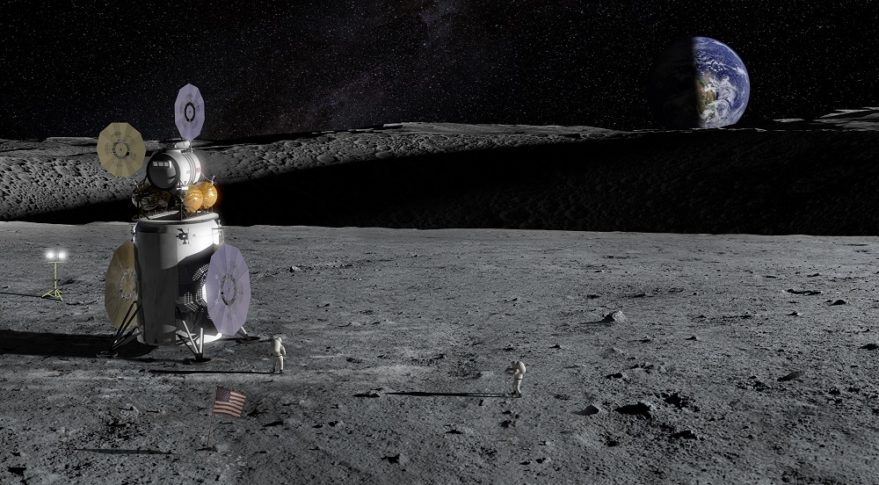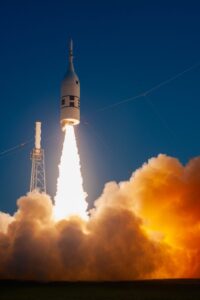How NASA’s return to the moon will be different from its first journeys thereby Jeff Foust — August 2, 2019
This article originally appeared in the July 29, 2019 issue of SpaceNews magazine.
 NASA’s renewed effort to return humans to the moon draws inescapable parallels to Apollo a half-century ago. Credit: NASAOn two July mornings nearly 50 years apart, a capsule stood atop a rocket, ready for NASA’s next step in sending humans to the moon. In July of 1969, the capsule was the Apollo 11 spacecraft atop its Saturn V rocket at Launch Complex 39A, ready to send Neil Armstrong, Buzz Aldrin and Michael Collins on their historic mission to the moon.
NASA’s renewed effort to return humans to the moon draws inescapable parallels to Apollo a half-century ago. Credit: NASAOn two July mornings nearly 50 years apart, a capsule stood atop a rocket, ready for NASA’s next step in sending humans to the moon. In July of 1969, the capsule was the Apollo 11 spacecraft atop its Saturn V rocket at Launch Complex 39A, ready to send Neil Armstrong, Buzz Aldrin and Michael Collins on their historic mission to the moon.
In July of 2019 it was a little different. The capsule was an Orion spacecraft — or, rather, a boilerplate version of the spacecraft with the same mass and dimensions but without all the internal systems of that next-generation crewed spacecraft. The rocket it was on was not the Saturn V or even the Space Launch System, but instead a refurbished Peacekeeper rocket motor, set up at Launch Complex 46, several kilometers down the coast from LC-39A.
The rocket would not send Orion to the moon, but instead to an altitude of about 10 kilometers, high enough and fast enough to test Orion’s launch abort system in conditions like those it would experience during a full-fledged SLS launch of the spacecraft. The test, called Ascent Abort 2 (AA-2), was a key milestone toward a first crewed flight of Orion, now expected for 2022.
It also, though, hearkened back to Apollo. During the Apollo program five Little Joe 2 rockets launched Apollo boilerplate spacecraft to test that spacecraft’s launch abort system, much like the AA-2 test more than 50 years later. NASA conducted its one and only in-flight test of Orion’s abort system July 2 at Cape Canaveral Air Force Station, Florida. Credit: NASA Kennedy Space Center“They’re very similar,” said Mark Kirasich, NASA’s Orion program manager, comparing AA-2 to the Little Joe 2 tests at a press conference the day before the test. One difference, he noted, is that Orion’s launch abort system has an attitude control motor that the one for Apollo lacked, giving more control over the orientation of the module after it escaped from the rocket.
NASA conducted its one and only in-flight test of Orion’s abort system July 2 at Cape Canaveral Air Force Station, Florida. Credit: NASA Kennedy Space Center“They’re very similar,” said Mark Kirasich, NASA’s Orion program manager, comparing AA-2 to the Little Joe 2 tests at a press conference the day before the test. One difference, he noted, is that Orion’s launch abort system has an attitude control motor that the one for Apollo lacked, giving more control over the orientation of the module after it escaped from the rocket.
Another difference is that Apollo performed five in-flight tests of the abort system, while AA-2 was the only one NASA planned to carry out for Orion. “We’re building on the work they did” in Apollo, Kirasich said of that difference. That experience, he said, showed that they needed to perform only two tests of the escape system: the in-flight abort test of AA-2 and a pad abort test that NASA performed in 2010.
Technology has also improved. “The tools that we have available to us are much better,” he said, such as computational fluid dynamics modeling of the system. “We take all of those things into account, and that’s how we decided two is the right number.”
BUILDING ON THE FOUNDATIONS OF APOLLONASA’s renewed effort to return humans to the moon draws inescapable parallels to Apollo a half-century ago. The Orion abort test is just one example of how NASA is drawing upon the experience of Apollo, but also modifying it to account for changes in technology, and in budgets, for Artemis.
In some cases, NASA is literally building upon Apollo. Facilities at the Kennedy Space Center built for Apollo, like Launch Complex 39B and the Vehicle Assembly Building (VAB), are still in use today, and will be the places where the vehicles that send humans back to the moon under the Artemis program are assembled and launched.
“We are leveraging 60 years of experience and investment to help NASA launch the next 40-year program, and that is what we are expecting Artemis to be,” said Lorna Kenna, vice president and deputy general manager of Jacobs Space Operations Group, a contractor working on that infrastructure at KSC.
Jacobs has been working with NASA to upgrade many of those Apollo-era facilities. “From the outside, a lot of the facilities at Kennedy may look the same,” she said, “but inside, a lot has changed.” Computer-controlled systems have replaced manual valves and switches, and new platforms in the VAB are in place to support processing of the SLS. The Apollo-era crawler-transporter, which carries the mobile launch platform from the VAB to the launch pad, has also been upgraded.
While Artemis may launch on the foundations of Apollo, both NASA and industry acknowledge that many other aspects of Artemis will be very different. The urgency of the original race to the moon allowed NASA to rapidly acquire what it needed to achieve President Kennedy’s goal of a man on the moon by the end of the 1960s.
A case in point was the lunar module, or LEM. “In 1962, 11 firms were invited to submit proposals for the LEM. Nine companies responded in September of that year,” recalled Jeff Foote, vice president of NASA programs at Northrop Grumman Innovation Systems. “Grumman Aircraft was awarded the contract two months later.”
No one expects NASA to return to that pace of contracting for Artemis, but those companies already involved in the program are hoping to at least secure sustained funding. “In addition to the total amount, the phasing of this is important,” said Tony Antonelli, mission director at Lockheed Martin for the second flight of the Orion, now called Artemis-2. U.S. President Donald Trump, who has sent mixed signals on his support of NASA’s moon plans, speaks with Apollo 11 astronaut Buzz Aldrin, right, on July 19 at the White House. Credit: White House TwitterFunding of Orion and SLS has not followed an optimal profile, rising up to a peak before tailing off as development wraps up. Instead, funding has been relatively flat for both. “We didn’t follow the optimum funding phasing profile through development, so it took us longer and probably cost more to get to here,” he said. “But we’re here now, so we can get to this production phase.”
U.S. President Donald Trump, who has sent mixed signals on his support of NASA’s moon plans, speaks with Apollo 11 astronaut Buzz Aldrin, right, on July 19 at the White House. Credit: White House TwitterFunding of Orion and SLS has not followed an optimal profile, rising up to a peak before tailing off as development wraps up. Instead, funding has been relatively flat for both. “We didn’t follow the optimum funding phasing profile through development, so it took us longer and probably cost more to get to here,” he said. “But we’re here now, so we can get to this production phase.”
There’s also the question of how much Artemis will cost. During at least the early phases of the Apollo program, Congress provided NASA with a blank check as it developed the launch vehicles, spacecraft and other infrastructure needed. A recent study by The Planetary Society estimates that Apollo, in 2019 dollars, cost $288 billion.
That sort of money isn’t forthcoming for Artemis. NASA Administrator Jim Bridenstine made headlines in June when he told CNN he estimated that Artemis would cost $20 billion to $30 billion on top of the agency’s existing budgets through 2024, although the agency hasn’t provided more details about that estimate since then.
Industry sees that cost estimate as a reasonable one. Frank Slazer, vice president for strategy and business development at Aerojet Rocketdyne, noted that the one key element of Artemis not included in those earlier budget projections is a lunar lander. “The lunar lander, if you go back to the Apollo era, was about $30 billion” in 2019 dollars, he said, an estimate supported by The Planetary Society’s analysis. “So that’s probably about right if you want to think about developing a lander capability.”THINKING DIFFERENT ABOUT ARTEMISBridenstine, in a July 12 interview on C-SPAN, suggested the additional cost of Artemis could be less than $20 billion, thanks to contributions from commercial partners that he says would be willing to invest their own money because they see other applications of the landers and other systems developed for Artemis.
“What we’re learning is that there are other people that want to contribute to this,” he said. “They want to invest their own money. Why? Because they want customers that are not NASA. If they have customers that are not NASA, it drives down our costs.”
Bridenstine is well aware of the historical weight of Apollo, but doesn’t feel driven to follow precisely in its footsteps. Bridenstine, born in 1975, often notes he is the first NASA administrator not to have been alive when Apollo astronauts walked on the moon.
“We’re learning from Apollo what not to do,” he said. “The challenge with Apollo is that it ended. It was not sustainable because the costs were too high.” That’s a key reason, he said, he’s looking for greater commercial roles in Artemis.
An example of that desire for commercial partnerships is how the agency plans to procure a lunar lander. On July 19 — the day before the 50th anniversary of the Eagle landing on the moon — NASA issued a draft solicitation for what it calls a Human Landing System Integrated Lander. That will support development of an initial lander for the 2024 mission and a more advanced lander, capable of carrying more astronauts for longer stays, two years later.
NASA expects to pursue development of the integrated landers through a public-private partnership approach, which the agency says in the draft solicitation is “part of creating a sustainable lunar exploration program.” NASA also doesn’t plan to take ownership of the lander or landers it ultimately procures, instead procuring landing services from the company providing the lander.
NASA requires that companies proposing landers contribute at least 10% of the total cost of the system. Two days before NASA released the draft, Bridenstine told senators that some unidentified companies had offered to contribute 30% or more of the lander’s costs because of the non-NASA applications they see for it.
In another departure from Apollo, that initial solicitation will lead to multiple initial awards with NASA ultimately selecting two companies to proceed with full-fledged lander development. “That mitigates risk,” he said, “because if something goes wrong with one, the others go forward, and we can stay on schedule.”UNCERTAIN GOALSUnlike Apollo, which had the primary goal of getting humans to the moon before the Soviets, Artemis is a means to a greater end, Bridenstine argued. “We need to keep our eyes on the horizon goal. The goal is not the moon. The goal is, in fact, Mars,” he said in the C-SPAN interview.
NASA has, in the last month, made a greater effort to emphasize Mars, particularly after President Trump tweeted that NASA “should NOT be talking about going to the Moon – We did that 50 years ago.” Bridenstine, in the interview, noted he had talked to the president since that tweet to reaffirm that NASA’s long-term goal was Mars, with the moon as a “waypoint” toward that goal.
“He said very clearly, ‘I know you’ve got to go to the moon to get to Mars, but talk about Mars,’” Bridenstine said of his conversation with Trump. “We are going to continue talking about why we’re going to the moon. It’s the proving ground for the mission to Mars.”
The president, though, is still thinking about skipping the moon. “To get to Mars, you have to land on the moon, they say. Any way of going directly without landing on the moon? Is that a possibility?” he asked at a July 19 Oval Office event to mark the Apollo 11 anniversary. NASA Administrator Jim Bridenstine testifying July 17 at a Senate Commerce Committee hearing on U.S. moon and Mars exploration plans. Credit: NASA/Bill IngallsBridenstine and Vice President Mike Pence made the case for the current program, explaining how the moon will be a proving ground for those later Mars missions. But the two Apollo 11 astronauts in the room disagreed. “Mars direct,” Michael Collins said, while Buzz Aldrin said he was “a little disappointed in the last 10 to 15 years” and criticized the performance of the SLS and Orion.
NASA Administrator Jim Bridenstine testifying July 17 at a Senate Commerce Committee hearing on U.S. moon and Mars exploration plans. Credit: NASA/Bill IngallsBridenstine and Vice President Mike Pence made the case for the current program, explaining how the moon will be a proving ground for those later Mars missions. But the two Apollo 11 astronauts in the room disagreed. “Mars direct,” Michael Collins said, while Buzz Aldrin said he was “a little disappointed in the last 10 to 15 years” and criticized the performance of the SLS and Orion.
“Well, I’d like to have you also listen to the other side because some people would like to do it a different way,” Trump eventually told Bridenstine after the NASA administrator explained why the agency was going back to the moon before Mars. “I would like to hear the other side also. Right?”
Assuming NASA’s current plans survive presidential prevarications, Bridenstine believes going back to the moon, and on to Mars, will have the same kind of impact on society as the Apollo 11 landing 50 years ago had worldwide. “When we celebrate the 50th anniversary of Apollo,” he said on C-SPAN, “the whole world is watching all of this programming with us, celebrating with us, and this shapes the perceptions of people all over the world toward the United States of America in a very positive way.”
As Bridenstine spoke, engineers were studying the data collected during the AA-2 abort test 10 days earlier. An initial look at the data indicated that the launch abort system performed as planned, pulling the Orion away from its booster as expected, like its predecessor systems did in similar tests a more than 50 years earlier for Apollo.
That successful test brings NASA one step closer to returning humans to the moon. “The next big check mark is the moon,” Kirasich said.Source:
https://spacenews.com/how-nasas-return-to-the-moon-will-be-different-from-its-first-journeys-there/